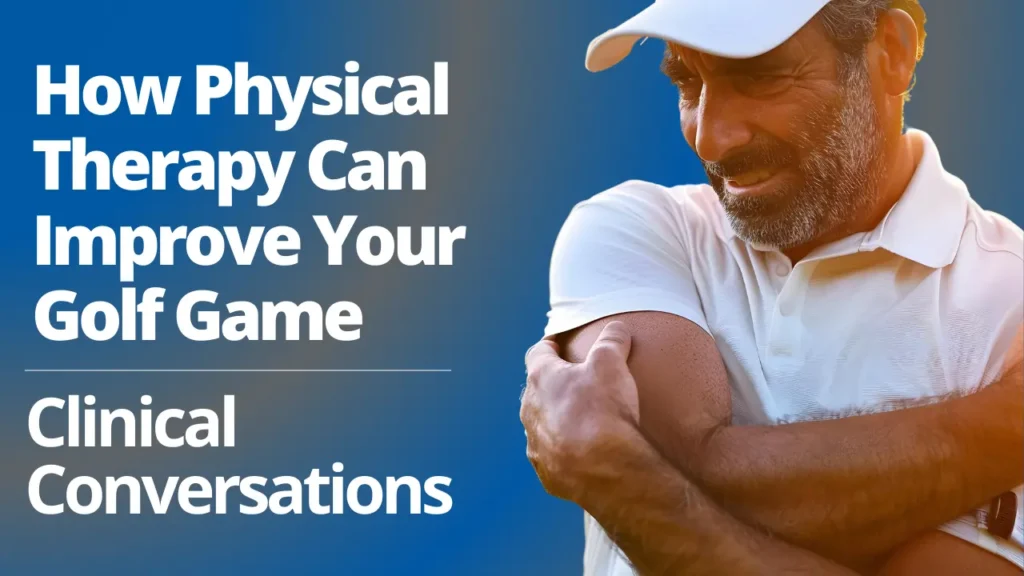
This blog explores how physical therapy can enhance your golf performance and prevent injuries.
Golf is a popular yet physically demanding sport. Although enjoyed by millions, it can lead to various injuries if not played correctly. This article was created from insights shared by physical therapists Matthew Lorimer and Ashley Langford, who discussed physical therapy and golf performance in this Clinical Conversations episode.
Understanding Common Golf Injuries
Golf, though a low-impact sport, frequently causes specific injuries.
Matthew Lorimer, a clinic manager and physical therapist at CORA, highlights low back pain and elbow issues, such as tennis elbow or golfer’s elbow, as the most common. These injuries can significantly hinder performance and reduce enjoyment of the game.
Addressing pain and injuries through physical therapy not only helps in recovery but also prevents future occurrences.
The Critical Role of Communication in Physical Therapy
It’s important to call your therapist at the onset of golf-related discomfort or pain.
Sharing that your pain might be linked to golf helps tailor the treatment to your specific needs. This also helps align your therapy plan with your goal of returning to golf pain-free. Effective communication ensures that treatments are customized, addressing the root cause of pain rather than just the symptoms.
How Physical Therapy Addresses Golf Injuries
Physical therapists (PTs) specialized in treating golfers employ a holistic approach in treatment.
PTs consider not just the physical symptoms but also factors like lifestyle, sleep quality, nutrition, and hydration.
For golfers, therapy focuses on a treatment plan that considers the biomechanics of a golf swing. This approach helps in crafting interventions that are not only therapeutic but also preventive.
The biomechanics of golf create complex challenges for the human body. The lumbar spine, for example, does not naturally support rotation and is often strained during the golf swing. Physical therapy can help enhance mobility and strength in the lumbar region, reducing the risk of injury.
Golf Swing Mechanics and Physical Therapy
Understanding the mechanics of a golf swing is crucial in physical therapy.
Knowing how different body parts are engaged during the swing helps therapists identify potential areas of stress and strain. Therapists who have personal experience in golf often have enhanced insight into common injuries and recovery techniques, making their approach more effective.
Certifications and Courses for Golf-Focused Therapists
For therapists interested in specializing in golf rehabilitation, obtaining certifications like the Titleist Performance Institute (TPI) certification is beneficial.
Th TPI certification provides therapists with a deep understanding of golf’s biomechanics and functional movements. A well-designed course should give a comprehensive overview from the origins of golf to the specifics of golf swing mechanics.
Collaboration with Golf Professionals
Effective collaboration between physical therapists and golf professionals is crucial.
Golf pros can provide valuable insights into a golfer’s technique, which may contribute to their pain or injury. This collaborative approach allows for a nuanced understanding of each golfer’s needs, leading to more effective treatment and improved performance on the golf course.
Expanding the Scope of Physical Therapy in Golf
Physical therapy’s role extends beyond treating injuries; it also involves enhancing performance and ensuring that golfers can enjoy a long-term engagement with the sport.
Therapists work on improving flexibility, strength, and overall physical health, which are crucial for golfers of all levels. As the science of sports and movement progress, so do the golf-specific performance training and injury treatment programs.
Preventative Strategies in Physical Therapy for Golfers
Preventative care is becoming increasingly important in sports therapy.
Physical therapists can help you golf by providing proper warm-up techniques, posture correction, and swing mechanics, which are essential for injury prevention. Regular sessions with a therapist can keep common golf injuries at bay and improve overall performance.
The Integral Role of Physical Therapy in Enhancing Golf Performance
Physical therapy is indispensable for both amateur and professional golfers.
PT helps in the quick recovery from injuries, improves golf performance, and prevents future injuries. By understanding the specific physical demands of golf, therapists can create targeted treatment plans that allow golfers to play safely and effectively.
Insights from experts like Lorimer and Langford underscore the significant benefits of a well-rounded approach to physical therapy in the world of golf.
This comprehensive blog outlines the importance of physical therapy in golf and also provides actionable insights for golfers and clinicians alike. Whether you are seeking to recover from an injury or aiming to enhance your golf game, incorporating physical therapy into your routine can lead to substantial improvements and a healthier, more enjoyable golfing experience.